Harry Sunley FSA
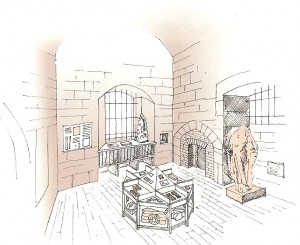
The project has been named in honour of the late Harry Sunley FSA, who was the authority on the Abbey until his death in 2011. Harry was a former Clerk to Kenilworth Town Council, past President and Chairman of Kenilworth History and Archaeological Society and past Chairman of the Kenilworth Abbey Advisory Committee. He had always hoped to see the Gatehouse chambers opened to the public and their contents properly displayed there, and these are now the ultimate aims of the Project.
The main works identified to achieve these aims are to strip out the existing metal storage racking in both chambers to expose the original walls and floors. The carved stones and boxes of floor tiles displaced by this operation will be rehoused on a new mezzanine platform in the inner chamber, where there was a mezzanine floor in the Middle Ages. Some of the heavier objects will be stored on a new set of shelves underneath the mezzanine, and also in a new specially made octagonal storage and display table in the outer chamber.
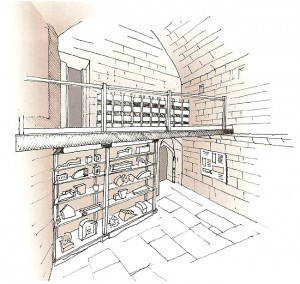
The freeing-up of space in both chambers should also allow us to exhibit properly large objects such as the 14th-century stone effigy of Prior John Salle (currently stored in the Barn) and the old stile from the Gatehouse passage. It will also be essential to bring mains electricity to the Gatehouse, to provide power for lighting.
To open the Gatehouse to the public would considerably extend the attraction of the Abbey site and encourage more visitors to Abbey Fields. Visits would take place on the same basis as the current summer opening of the Barn by volunteer stewards from Kenilworth History and Archaeology Society, and on pre-booked guided tours. The Gatehouse and the Barn together also have considerable potential as an educational focus for school groups on aspects of medieval monastic life.
St Mary’s Abbey and Its Gatehouse
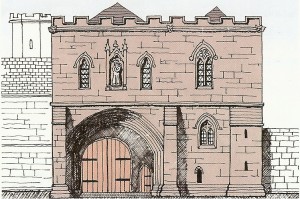
The ruined ‘Tantara’ Gatehouse in Abbey Fields, Kenilworth (Warwickshire) is the most significant standing remain of the Augustinian priory (later abbey) of St Mary, founded in 1119. It was originally an imposing two-storey building controlling the inner court of the monastery. It was rebuilt mainly in the time of Prior Henry Bradway (1361-75), and thus contemporary with John of Gaunt’s great rebuilding at the Castle.
The Suppression of the monastery in 1538 destroyed the upper storey and almost all the surrounding buildings, but much of interest still survives on the ground floor, and a popular footpath still runs under the vaulted arch where carts and pedestrians passed in the Middle Ages.
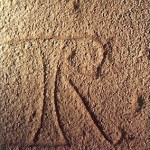
The two surviving chambers form what appears to have been a well-appointed porter’s lodge; the lost rooms above were probably accommodation for an important monastic official, such as the bailiff. The surviving structure was in use as a cottage in the 17th and 18th centuries, quite cosy with its thick walls and stone vaults: a cooking range inserted into the medieval fireplace provides evidence for this domestic usage.
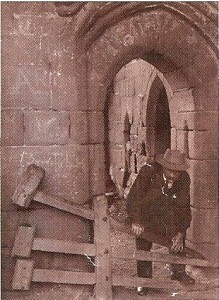
It had become a picturesque ruin by the time the graveyard of St Nicholas’s church was extended around it in 1885. During the Great War, it was used for drying herbs. It is a Grade I listed building and a rare survival of a gatehouse of the Augustinian monastic order.
It is the most important medieval building in Kenilworth after the Castle and St Nicholas’s parish church. It is maintained by Warwick District Council, with advice from Kenilworth Abbey Advisory Committee.
The Harry Sunley Memorial Project is a registered charity (no. 1166561). For more information on the charity see www.harrysunleymemorialproject.org.uk or follow the Harry Sunley memorial Project via Facebook. If you want to donate to help the project reach its fund raising goals, see the donation form attached below.
How to Donate to the Harry Sunley Memorial Project
The Kenilworth Abbey Advisory Committee (KAAC) is responsible for the project and estimates that the cost of the necessary works and equipment will be £50,000.
KAAC has no regular source of income, so will need to raise this money through an appeal to grant-giving bodies, donors and the general public.
The main items requiring funding are:
- The construction of a mezzanine platform in the inner chamber
- A bespoke unit for storage and to support the mezzanine platform
- A bespoke octagonal display/storage unit for the outer chamber Lighting
- Display boards
- Professional services, e.g. Architect and structural Engineer fees
PLEASE HELP US RAISE THIS MONEY
Donations, however small, are most welcome. You might care to sponsor small individual items like the display boards,or larger items like the mezzanine platform, or the octagonal display/storage unit.
*The Appeal excludes the cost of bringing mains electricity to the Gatehouse, which the KAAC anticipates will be borne by the Local Authority
An Adobe PDF version of the donation form can be found below. If you wish to donate, fill in the form, enclose a cheque for your donation and return it by post to the address shown on the form. If you are a UK tax payer, don’t forget you can Gift Aid your donation which will allow the charity to claim an extra 25p for every £1 you give:
Adobe PDF donation form for the Harry Sunley Memorial Project.
This Post Has 2 Comments
Comments are closed.

Pingback: Work to begin on Kenilworth Abbey Gatehouse - Kenilworth History and Archaeology Society (KHAS)
Pingback: February 2020 Newsletter - Kenilworth History and Archaeology Society (KHAS)